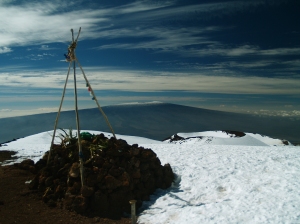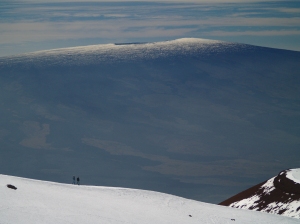
Polynesians encountered the snow goddess, Poliahu, for the first time when they reached the Big Island of Hawaii sometime in the Fourth Century C.E. and beheld the snow-clad summits of the great volcanoes. The eldest daughter of the sky god Kane, Poliahu is said to have created the verdant, tropical beauty of the Hamakua Coast on the Big Island; its lushness, clear, cold streams and lovely waterfalls a perfect playground for her to indulge in her favorite pass-time--cavorting with human men.
Though she regularly visits Haleakala on Maui and Mauna Loa on the Big Island, Mauna Kea--in Hawaiian the "White Mountain"--is rightly considered the home of Poliahu. The prominent surviving myth about the Goddess Poliahu involves her besting the Volcano Goddess, Pele, at the Hawaiian sledding sport of "he'eholua". So angry was Pele at being defeated that she attacked Poliahu with streams of glowing lava. Poliahu retaliated by bringing down storms of snow to freeze the molten rock in place. The goddesses fought each other to a standstill, although the sledding defeat has always rankled Pele. Even now as she dominates at Kilauea, Pele submits to Poliahu's rule on Mauna Kea; still, to this day, Pele is said to dispute with Poliahu over Mauna Loa.
Hikers on the Summit Ridge of Mauna Kea; Mauna Loa in the Background: Photo by Donnie MacGowan

Mythology aside, Mauna Kea's summit is an exciting, fascinating place. A dormant shield volcano which hasn't erupted for about 4500 years, Mauna Kea is 13,803 feet tall, the highest point in the state of Hawaii. Because the summit rises some 33,476 feet above its base on the sea floor, Mauna Kea is the tallest mountain on earth. All this mass, this huge bulk of a mountain has grown in fewer than a million years--geologically the blink of an eye. Glaciers covered the summit of Mauna Kea three times between 200,000 and 13,000 years ago, leaving behind many glacial features and a few remnant rock glaciers near the summit. In addition, the summit area is home to Lake Waiau, the seventh highest lake in the United States. Also on the summit block is the largest, and most modern collection of international astronomical observatories located anywhere on earth.
The Summit of Mauna Kea Contains a Small Metropolis of the Most Modern and Sophisticated Astronomical Telescopes and Observatories in the World: Photo by Donnie MacGowan

I love visiting the summit of Mauna Kea--whether I spend the day hiking the six-mile trail to the top or I drive to the end of the road for the 10 minute walk up the summit at Pu'u Weiku. I spend hours and hours watching the clouds, listening to the silence, soaking up the island-wide vistas. I'm not sure what draws me out of the tropical torpor of Kona, time and again, to the summit of Mauna Kea--maybe the exhilaration of altitude and the crisp, clean air, or the opportunities for snow-play, solitude; perhaps unconsciously I hope to see one of the legendary cat-fights between Pele and Poliahu, fire and ice.
Secretly, deep down, I suspect that honestly I am just hoping to become yet another in the long, long line of human men that Poliahu has chosen to, ahem, cavort with.
For more information about traveling to the Hawaii in general and touring the Big Island in particular, please visit www.tourguidehawaii.com and lovingthebigisland.com. For a video about hiking up Mauna Kea, go here. For information about the author, please go here.

No comments:
Post a Comment